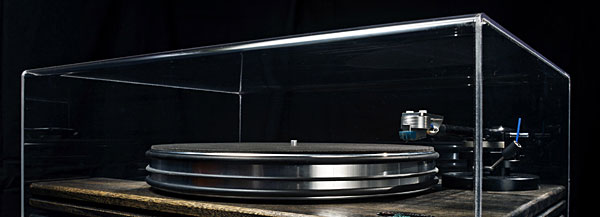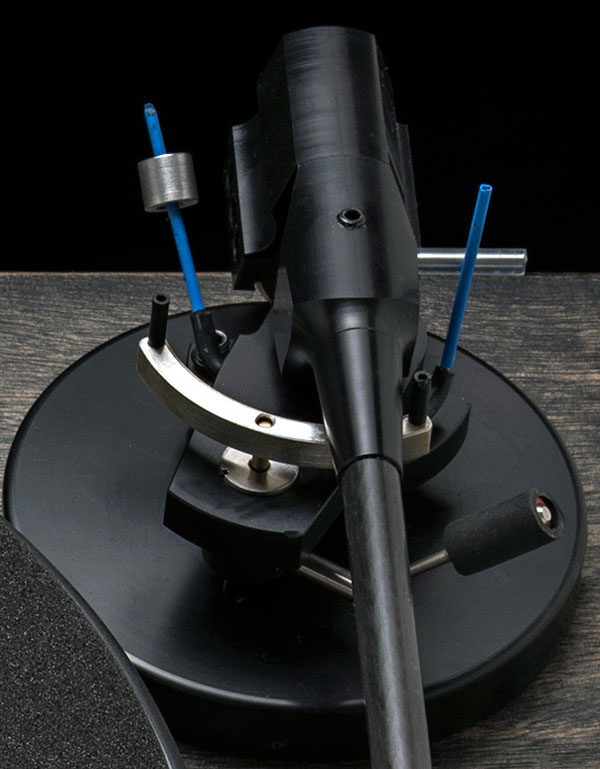| Columns Retired Columns & Blogs |
did hear it at CES 2015 paired with Larsen Speakers - the resulting sound was very engaging, musical and easy to sink into. Cool looking to boot!
Jerry Cmehil
Designer
Well Rounded sound Inc.
Listening
This may not be the sort of praise for which Pear Audio longs, but the Kid Howard–Cornet 2 combination sounded surprisingly good. By which I mean: Given the turntable's decidedly torqueless motor, and the Stutz Bearcat technique required to get its platter spinning, I didn't expect a great deal of touch and force and tactile nuance. Indeed, the Pear Audio didn't provide those qualities in the same measure as do such conspicuously torquey 'tables as the Garrard 301—but provide them it did, often to a satisfying degree. And with them came other qualities that ranged in strength from impressive to striking.
Striking is a fitting description of the player's powers of scale: The Kid Howard and Cornet 2 created a soundfield that was engagingly, involvingly big. And the parts of that soundfield that weren't music were impressively "black": lots of big, black nothingness surrounding very colorful music. Very, as in very.

The Pear Audio did better-than-average jobs with musical timing, momentum, and flow, even if its overall sense of drive wasn't the best. From Scottish Country Dances, by Jimmy Shand and his band (10" mono LP, Parlophone PMD 1029), "Foursome Reel"—a Scottish cousin of the bluegrass fiddle tune "Devil's Dream"—was energetically involving: The music's upbeats, emphasized by piano and a slightly anachronistic-sounding modern drum kit, came across with fine snap and drive. And in "Alabamy Bound," from Ray Charles's The Genius Hits the Road (LP, ABC-Paramount ABC-335), the double bass and bongos (yes, bongos!) were well timed, with decent tactile qualities. The Kid Howard and Cornet 2 were good at communicating more nuanced timing, as well: The combination could swing—as it did during Mal Waldron's 5/4 "Warp and Woof," from The Quest (LP, New Jazz NJ-8269/Original Jazz Classics OJC-082). Better still was how the Pear pulled tons of tone from that groove: Booker Ervin's tenor sax, during both his solo and his duet with Eric Dolphy (on alto), had terrific color and texture, as did Ron Carter's beautiful solo cello.
In fact, all kinds of strings sounded beautifully lush through the Pear Audio combo. Used to play the classic recording of Ralph Vaughan Williams's Fantasia on a Theme by Thomas Tallis, by Sir John Barbirolli and the Sinfonia of London (LP, EMI ASD 521), the Kid Howard was like a window opened on a great, rolling field of tone and texture. And the Pear's grand sense of scale suited that LP's convincingly spacious stereo sound, which itself suits the music's sweep. Appropriately, there was less sweep but more swoop in the player's way with the recording of Vaughan Williams's The Lark Ascending by Sir Adrian Boult and the New Philharmonia, with violinist Hugh Bean (LP, EMI ASD 2329): Transcribed by the Kid Howard, Bean's violin was liquid in its sound, perfectly intonated, and unignorably moving. And the strings in the recording by Colin Davis and the London Symphony Orchestra of Michael Tippett's Symphony 2 (LP, Argo ZRG 535)—put to a very different use than in the Vaughan Williams recordings—were forceful and present, with especially good touch and texture in the sounds of double basses.
Huge waves of tone were also heard in "Raga Rageshri," from Ravi Shankar's Improvisations (LP, World Pacific 1416), especially in the sitar phrases and tambura drone that open the piece. Just as notable, in the jazzier "Fire Night," from the same album, the tabla had a good if not great sense of touch, as did the note attacks in the phrases played on nylon-string guitar and double bass. The Kid Howard's good tactile qualities followed it to other types of music, as the player did a really fine job with the note attacks in the electric-bass line (is that a Fender Bass VI I hear in the right channel?) and the tightly composed drumming in "Young and Innocent Days," from the Kinks' Arthur (LP, Reprise 6366).

Vocal performances, too, were realistically full and well textured through the Pear combo, as with Sarah Vaughan's great mono recording of "Nice Work If You Can Get It," from Sarah Vaughan in Hi-Fi (LP, Columbia CL 745). Vaughan's voice was also reproduced with good presence and substance—descriptors that applied equally well to the sounds of Miles Davis's trumpet solo, and the sax-and-trumpet tag at the end of the song. And James Brown's "It's a Man's Man's Man's World," from the recent Love Power Peace (3 LPs, Polydor/Sundazed Music 5470)—a song that not only sounds best when played loud, but must be offered as a gift to one's neighbors—was simply incandescent.
One characteristic of the Pear Audio combination remains to be described: This player had excellent scale, very good tone and texture, very good momentum and timing, and fair touch and impact—but it also tended to roll off the extremes of the treble range to a slight but consistently audible degree. I could hear some timbral rounding-off of the French horn in the Sicilienne of Fauré's Pelléas et Mélisande, with Ernest Ansermet and the Suisse Romande Orchestra (LP, Decca/Speakers Corner SXL 2303); in both the guitar and voice in the title song of Nick Drake's Pink Moon (LP, Island/Universal 1745697); in all of the voices and instruments in "Whizz Kid," from Mott the Hoople's indispensable Mott (LP, CBS 69038)—really, just about everything I played on the Pear was ever-so-slightly unbright. The characteristic was pervasive, consistent, and not at all troubling, except in those rare instances of LPs that were already, themselves, too dull.

Conclusions
In use, considered apart from its sonic performance, there were many aspects of the Kid Howard–Cornet 2 that I liked, and only one or two that I didn't. As for the former, I actually came to enjoy the turntable's start-up procedure. Setting in motion a platter whose energy source is always at the ready—with its AC cord plugged in, the switchless motor produces a continuous, subtle, anticipatory vibration, until summoned into action—reminded me of the unstruck bell in C.S. Lewis's The Magician's Nephew. (Unusual stories, like unusual audio components, have conventions of their own.) I also admired the turntable's appearance and general lack of fuss. In the latter column must go the wobbledy-clunk feel of the tonearm and the lack of a fingerlift on its headshell.
In a system that requires of its source components the last word in treble extension—or for a listener who's simply desirous of same—I don't think Pear Audio's Kid Howard–Cornet 2 combination would be ideal. Yet the obverse is no less true: For the listener whose system or tastes require a record player with the ability to sand off the edges before they reach a pair of overachieving tweeters, but without diminishing the musical and sonic details in the grooves, the Pear Audio combo may be just the thing.
In any event, the combination of Pear Audio Kid Howard turntable and Cornet 2 tonearm never failed to satisfy my cravings, even to excess, for good tone, texture, and scale. Which is to say that the Pear Audio never failed to sound analog, in some of the finest ways. For the user who desires a plug-and-play phonograph of appreciably better than entry-level quality, and whose system and tastes in sound are amenable to slightly soft trebles, the Pear pair is a very good choice.

did hear it at CES 2015 paired with Larsen Speakers - the resulting sound was very engaging, musical and easy to sink into. Cool looking to boot!
Jerry Cmehil
Designer
Well Rounded sound Inc.

I have noticed in the last several reviews that Mr. Dudley has done his reviews without his TD124 and only the Garrard 301. I wonder why?

Hi Volvic—I have tended to lean on one when the other requires work, and for the past several months I've been challenged in my efforts to get the TD 124's plinth just so. I'm getting closer—a good saw comes in handy—and in any event you'll see much more of the 124 beginning in the September and October issues and beyond. Thank you for reading my columns and reviews.